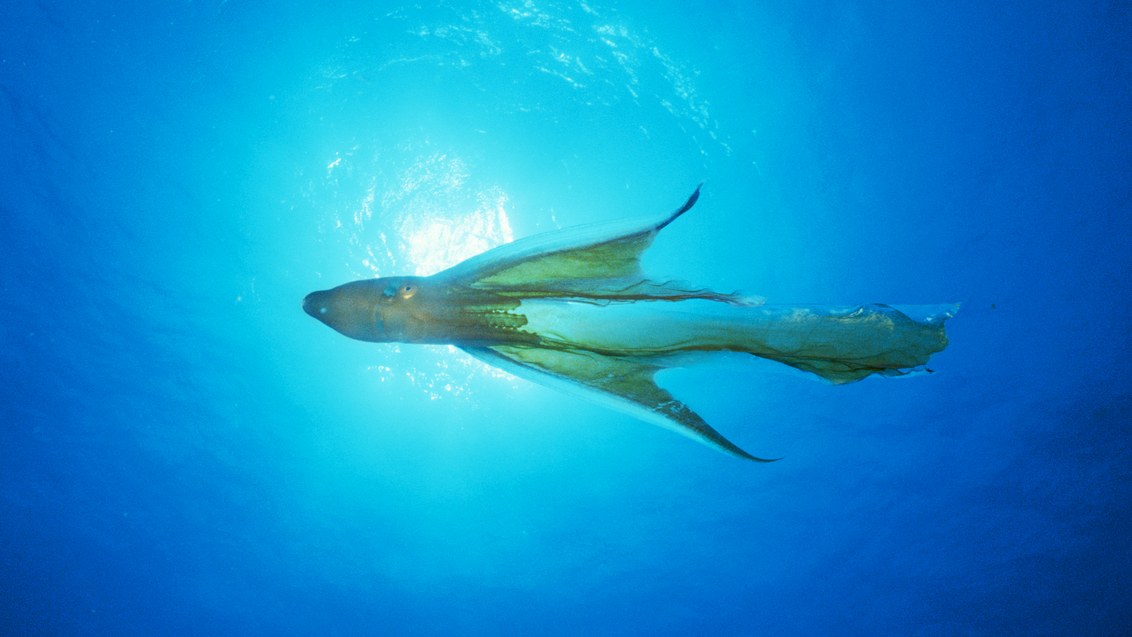Meet the Blanket Octopus
Learn all about the caped-crusader cephalopod of the ocean

In the cold months of wintertime, there is nothing I like more than covering myself with a warm homemade blanket and getting cozy on the couch. Unfortunately, in the ocean, the wildlife living there don’t have such a luxury. Let’s just say that if a fish were to try using a blanket octopus to cover its fins for a little warmth, it might end up as the next meal for the blanket octopus.
The blanket octopus
Kingdom: Animalia
Phylum: Mollusca
Class: Cephalopoda
Order: Octopoda
A very unique-looking creature, the blanket octopus (genus Tremoctopus) is rarely encountered by humans in the ocean. These octopuses are generally found swimming in both the subtropical and tropical ocean and living in either the open ocean or near coral reefs. The blanket octopus makes its home in the Australian Great Barrier Reef, the Gulf of Mexico, the Mediterranean Sea and the Indian Ocean. The blanket octopus roams the seas in search of food, finding a new destination every few days.
The blanket octopus is a carnivore that eats smaller fish. Cephalopods are known for their remarkable intelligence, and blanket octopuses are no exception. They have developed an immunity to the deadly stings of jellyfish tentacles. And, blanket octopuses have been known to rip the venomous arms off jellyfish and Portuguese Man O’Wars to use as weapons to hunt prey. YIKES! (Sleep with one eye open dearest jellyfish.)
Get Ocean Updates in Your Inbox
Sign up with your email and never miss an update.
Males versus Females
If you thought the tentacle-arm-weapon stealing was wild, brace yourself. Female blanket octopuses weigh 40,000 times more than male blanket octopuses. The male blanket octopuses are smaller than a walnut (and do not have a cape) while female octopuses are super-sized—having one long fleshy cape that encloses their arms. The female blanket octopus can grow up to six feet in length. The blanket octopus has the greatest gender size discrepancy of all animals.
Mating for the blanket octopus can be deadly. The male uses up most or all of its energy to mate, breaking off its third arm in the process and sometimes dying as a result. The female blanket octopus will then carry up to 100,000 eggs until they hatch. After the baby blanket octopuses hatch, the mother will die shortly afterwards. Female blanket octopuses have a lifespan of three to five years while males have a lifespan of one to two years.
Caped-crusader of the ocean
Imagine, for a moment, being a fish swimming along in the ocean. Here comes the female blanket octopus. (Watch out!) It fans out its giant cape, like a superhero or villain (depending on which one you are routing for) and wielding a jellyfish arm like a sword! Why hasn’t the female blanket octopus been the leading lady in a blockbuster movie yet?

There are four known species of blanket octopuses, and all species are listed as “least concern” (population trend unknown) on the International Union for Conservation of Nature’s Red List of Threatened Species. This listing is based on the limited data on blanket octopus due to their elusive nature and the lack of human sightings or encounters with them.
- Robson’s blanket octopus (Tremoctopus robsoni): This species is native to the south Pacific and is most commonly spotted in New Zealand.
- Indo-Pacific violet blanket octopus (Tremoctopus gracilis): One of the rarer species, it’s found in the Indian and Pacific oceans from Japan to Australia.
- Gelatinous blanket octopus (Tremoctopus gelatus): This species can be found in the Atlantic from Madagascar to the United States‘ southeast coast.
- Common blanket octopus (Tremoctopus violaceus): This species is found in Atlantic waters including off western Africa, Europe and North and South America.
Will you help the blanket octopus?
Blanket octopuses rely on healthy coral reef ecosystems to survive. Unfortunately, stressors such as climate change, ocean acidification, diseases, overfishing, sedimentation and pollution have degraded reefs around the world.
It’s up to all of us to help protect blanket octopuses, coral reefs and all the animals living in the ocean. Ocean Conservancy is working with you to protect the ocean from today’s greatest global challenges. Together, we create evidence-based solutions for a healthy ocean and the wildlife and communities that depend on it.
Please make a donation to Ocean Conservancy—give today and make a difference for the future of our ocean!